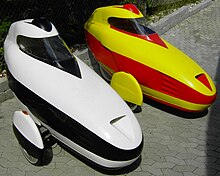
A bicycle, also called a pedal cycle, bike, push-bike or cycle, is a human-powered or motor-powered assisted, pedal-driven, single-track vehicle, having two wheels attached to a frame, one behind the other. A bicycle rider is called a cyclist, or bicyclist.

A recumbent bicycle is a bicycle that places the rider in a laid-back reclining position. Some recumbent riders may choose this type of design for ergonomic reasons: the rider's weight is distributed comfortably over a larger area, supported by back and buttocks. On a traditional upright bicycle, the body weight rests entirely on a small portion of the sitting bones, the feet, and the hands.

A tricycle, sometimes abbreviated to trike, is a human-powered three-wheeled vehicle.

A velomobile ; velomobiel, velo, or bicycle car is a human-powered vehicle (HPV) enclosed for aerodynamic advantage and/or protection from weather and collisions. Velomobiles are similar to recumbent bicycles, pedal go-karts and tricycles, but with a full fairing and are not to be confused with purpose-built mobiles for racing or speed records fully faired vehicles with two wheels, generally called streamliners. Streamliners have set many speed and distance records.

A feet first (FF) motorcycle is a class of motorcycle design which positions the rider with their feet ahead, like a car, rather than below and astride, as with conventional bikes. As there are other types of motorcycle that have a 'feet forward' position, an alternative term sometimes used is advanced single track vehicle. The name "feet first" was first used by Royce Creasey

The Twike is a human-electric hybrid vehicle (HEHV) designed to carry two passengers and cargo. Essentially a velomobile with an electrical hybrid engine, it can be driven in electric-only mode or electric + pedal power mode. Pedaling warms the user, making electric heating in winter unnecessary, extends the range of the vehicle but does not substantially add to the vehicle's top speed.
Pedal-powered vehicle may refer to:

A handcycle is a type of human-powered land vehicle powered by the arms rather than the legs, as on a bicycle. Most handcycles are tricycle in form, with two coasting rear wheels and one steerable powered front wheel. Despite usually having three wheels, they are also known as handbikes.
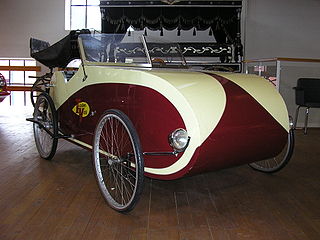
Fantom is a Swedish velomobile with four wheels, two in the front and two in the rear. It has no front suspension, but has suspension in the rear.
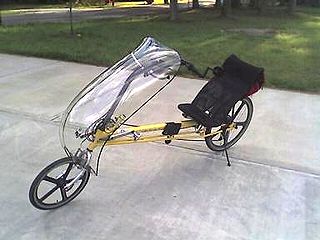
A bicycle fairing also called recumbent fairing is a full or partial covering for a bicycle to reduce aerodynamic drag or to protect the rider from the elements. It is more common to see recumbent bicycles with partial or full fairing. A bicycle with a full fairing is a regular bicycle fitted with an extra component, as opposed to a velomobile, which is a permanently enclosed bicycle.
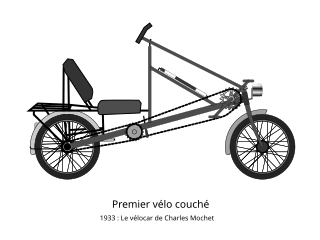
Velocar was the name given to velomobiles made in the 1930s and 1940s by Mochet et Cie of Puteaux, France and colloquially to the company's recumbent bicycles.

The People Powered Vehicle, or PPV, was a two-person pedal-powered car introduced in the United States during the oil crisis of the early 1970s. Manufactured by EVI of Sterling Heights, Michigan, it sold for less than $400. Although it offered luggage space and was marketed as a fun and practical vehicle, it offered limited weather protection and was not fast enough to substitute for a car.

Worksman Cycles is a family-owned American manufacturer of bicycles and tricycles for industrial, commercial and recreational use. The company was founded in 1898 and is headquartered in Ozone Park in the borough of Queens in New York City. Previously in the Spear Building the company also operates an additional factory in Conway, South Carolina. Worksman is the oldest bicycle manufacturer in the United States and has operated its own factory-direct e-commerce store since 2004.

A quadracycle is a four-wheeled human-powered land vehicle. It is also referred to as a quadricycle, quadcycle, pedal car or four-wheeled bicycle amongst other terms.

The following outline is provided as an overview of and topical guide to bicycles:
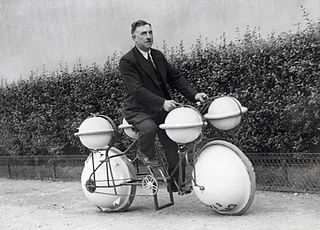
An amphibious cycle is a human-powered vehicle capable of operation on both land and water. The design which has received the most coverage is "Saidullah’s Bicycle." The bike uses four rectangular air filled floats for buoyancy which propelled using two fan blades which were attached to the spokes. "Moraga’s Cyclo Amphibious" uses a simple tricycle frame to support three floaters which provide both the flotation and thrust. The wings on the powered wheels propel the vehicle in a similar way to a paddle wheel.
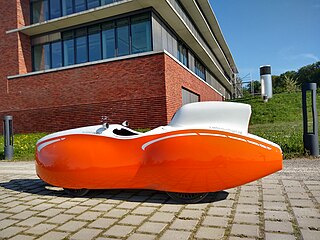
The Quatrevelo is a commercial-production velomobile which is notable for using both four wheels and also a highly aerodynamic fairing. The Quatrevelo is manufactured by Velomobiel.nl in the Netherlands, with the first production models delivered in 2016.
Carl Georg Rasmussen is a mechanical engineer with a PhD in physics; an ecologist specializing in noise pollution; and a light aircraft pilot. He is the designer and manufacturer of the Leitra velomobile.

Micromobility refers to a range of small, lightweight vehicles operating at speeds typically below 25 km/h (15 mph) and driven by users personally. Micromobility devices include bicycles, e-bikes, electric scooters, electric skateboards, shared bicycle fleets, and electric pedal assisted (pedelec) bicycles.
